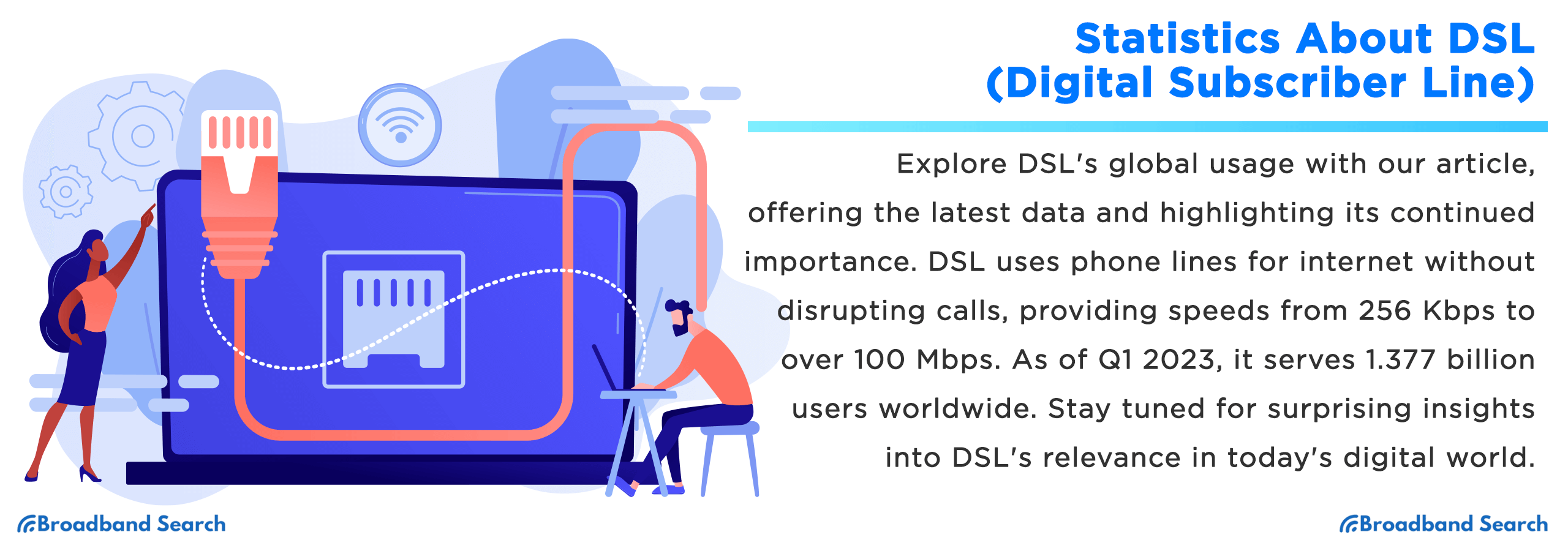Did you know that Digital Subscriber Line (DSL) isn't just your average internet service? It's a unique breed, using existing telephone lines to provide high-speed internet without disrupting telephone use. But what sets DSL apart in today's tech-savvy world?
DSL technology harnesses copper phone lines, offering internet speeds ranging from 256 Kbps to over 100 Mbps. It's a balancing act of speed and availability. In fact, as of Q1 2023, DSL accounts for a substantial portion of global internet subscriptions, catering to 1.377 billion users worldwide. So, if you're curious about how DSL stacks up in the digital landscape today, stick around – we're about to dive into some fascinating insights that might just surprise you.
DSL Evolution and Adoption
Early Development and Technological Milestones
From its inception to widespread commercial availability, DSL has undergone a remarkable journey through time. Here's a quick historical timeline that sheds light on its significant milestones:
- 1960s - Inception: DSL's journey began in the 1960s when engineers explored the possibility of transmitting digital data over existing telephone lines.
- 1970s - Conceptualization: The concept of DSL started to take shape as researchers worked on the theory of using different frequencies to carry data alongside voice signals.
- 1980s - Initial Trials: The first successful field tests of DSL technology were conducted, proving its feasibility.
- 1990s - ADSL Emergence: Asymmetric Digital Subscriber Line (ADSL) emerged, allowing faster download speeds while retaining voice capabilities.
- 2000s - VDSL Enhancement: Very-high-bit-rate Digital Subscriber Line (VDSL) further improved DSL speeds and paved the way for high-definition video streaming.
- 2010s: Vectoring and Bonding: Technological advancements like vectoring and bonding further enhance DSL performance.
- 2020s: Ongoing Development- DSL technology continues to evolve, with the latest statistics indicating its widespread use in homes and businesses globally.
Key technological advancements that shaped DSL include:
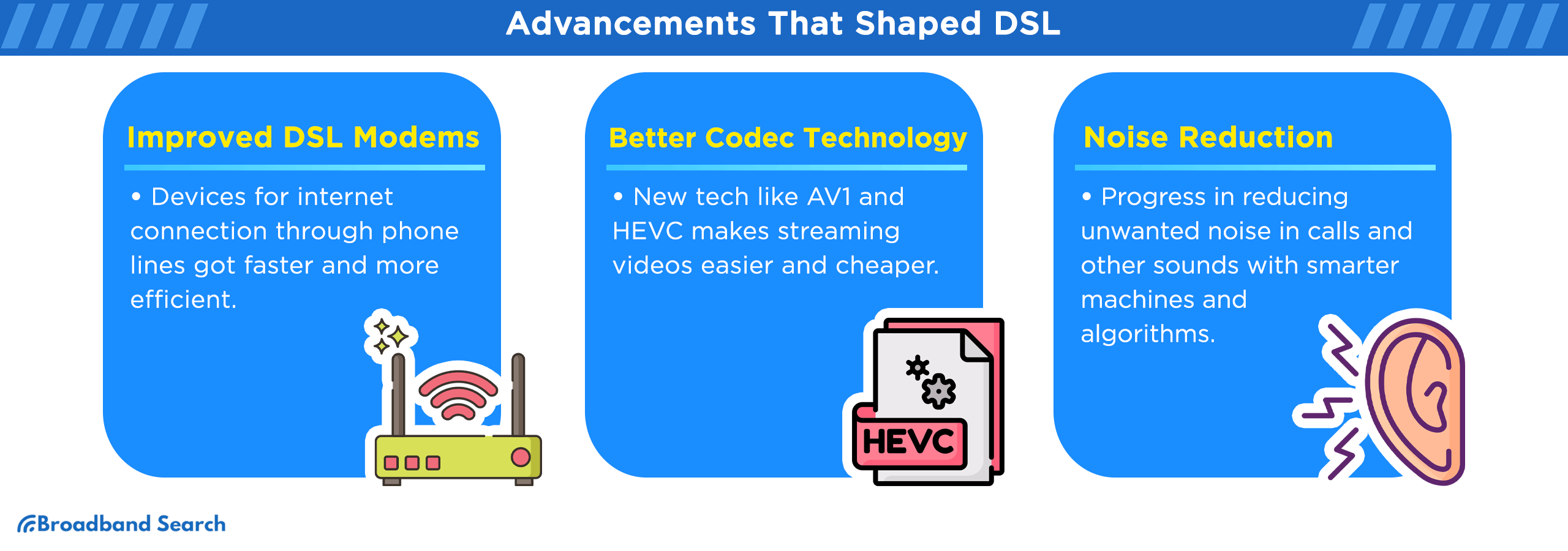
DSL Modems
DSL modems have played a critical role in the evolution of internet connectivity, enabling high-speed data transmission over existing telephone lines.
- Early Beginnings: The history of modem technology dates back to the late 1950s with the development of acoustic couplers. These early modems used audio tones for data transmission at speeds of 110 to 300 bits per second (bps).
- Significant Breakthroughs: In the 1960s, the Bell 103 and Bell 212A modems were introduced, reaching speeds of 300 bps and 600 bps, respectively. The 1980s and 1990s saw further advancements with the V.32 and V.34 standards, allowing for speeds up to 28.8 kilobits per second (Kbps).
- Rise of 56K Modems: The mid-1990s brought 56K modems, which utilized Pulse Code Modulation (PCM) technology, achieving data rates of up to 56 Kbps.
- Joseph W. Lechleider's Contribution: A key advancement in DSL was the asymmetric arrangement, which offered more than double the bandwidth capacity of symmetric DSL. This was crucial for services like ADSL (Asymmetric Digital Subscriber Line), favoring download speeds over upload speeds.
- Technology and Cost Reduction: Advancements in very-large-scale integration (VLSI) technology reduced the costs associated with DSL deployment. DSL could be deployed over existing cables, making it cheaper than installing new fiber-optic cables.
Codec Technology
Codec technology, vital for efficient video and audio data transmission, has undergone significant evolution, adapting to the changing demands of media consumption.
- AV1 Adoption: AV1 is increasingly being seen as the codec of choice for streaming media, thanks to its efficiency and royalty-free nature. Its adoption by major streaming services like Amazon, Google, and Netflix marks a significant shift in the codec landscape.
- HEVC for 4K: Despite its slower adoption, HEVC remains pivotal for delivering high-quality 4K video, offering significantly better compression than its predecessor, AVC.
- Continual Improvement: Ongoing advancements in codec technology are crucial for enhancing both new and old codecs. This ensures that all consumer groups benefit from high-quality video content, whether in HD or 8K.
Noise Reduction
Noise reduction technology has evolved significantly to address challenges in various environments, ranging from audio communication to aircraft noise.
AI in Noise Reduction: The continual expansion of AI in noise reduction is driven by advancements in machine learning algorithms and hardware capabilities, leading to widespread application in communication technologies.
Trends in DSL Technology Over the Years
The evolution of DSL technology didn't stop with ADSL. It's important to understand how ADSL transformed into VDSL and the technical improvements that came with it:
ADSL (Asymmetric Digital Subscriber Line)
- Top Speeds: Up to 8 Mbps downstream, and 1 Mbps upstream.
- Technical Improvements: Utilizes existing telephone lines. Splits bandwidth into three bands for data and voice, with greater bandwidth for downstream data.
- Impact on Users: Provided faster internet access than dial-up, suitable for home users and small businesses needing moderate download speeds.
VDSL (Very High Bitrate Digital Subscriber Line)
- Top Speeds: Up to 52 Mbps downstream, and 16 Mbps upstream. Some extenders offer 100 Mbps/60 Mbps speeds over short distances.
- Technical Improvements: Uses coaxial, fiber optic, or twisted pair cables for short distances. Employs Discrete Multitone Technique (DMT) for modulation, offering higher capacity than ADSL on short lines.
- Impact on Users: Enabled high-bandwidth applications like HDTV, video on demand, and high-quality video conferencing. More suited for applications requiring higher bandwidth.
Vectoring Technology
- Top Speeds: VDSL with vectoring tech boosts speeds; trials averaged 18% downstream increase, hitting 120 Mbps down and 30 Mbps up in some cases.
- Technical Improvements: Vectoring minimizes copper cable interference, enhancing VDSL performance with higher speeds, stability. Requires compatible modems, including G.INP for noise reduction.
- Impact on Users: Vectoring in VDSL improves speed, stability, ideal for bandwidth-demanding tasks in non-fiber areas, outperforming ADSL and non-vectored VDSL.
Factors Influencing the Adoption of DSL

Several factors play a pivotal role in the adoption of DSL technology, influencing how it competes with cable and fiber optics. Let's break them down:
Pricing
- DSL: Typically ranges from $50 to $100 per month.
- Fiber: Costs around $600 to $1500 per month, but entry-level plans can be as low as $30.
- Cable: Between $100 and $400 per month depending on speed.
Availability
- DSL: Available to 82.2% of the U.S. population.
- Fiber: Available to 51.5% of U.S. households.
- Cable: Cable modem service available to 84.3%of Americans.
Competition with Cable and Fiber Optics
- Technology: Fiber and cable offer higher speeds and better service quality compared to DSL.
- User Experience: Fiber provides symmetrical upload and download speeds and better latency than DSL.
- Market Share: The presence of only one or two high-speed internet providers leads to higher prices in many areas.
Regulatory and Infrastructure Challenges
Challenges in regulatory policies and infrastructure can impact DSL adoption:
- Legal and Regulatory Barriers: Complex telecommunications law can present challenges to broadband expansion, necessitating legal strategies and action plans for communities and ISPs. Certain legal barriers hinder local governments' broadband projects and partnerships, with some states restricting their access to federal and state funding.
- Federal and State Collaboration: Federal and state governments have invested billions in broadband deployment with mixed results. Understanding how funding sources overlap and where legal and regulatory guidance or rules may conflict is crucial for leaders at every level of government.
- Telecom Sector Evolution: The telecom industry, including 5G and other technologies, faces challenges like cybersecurity threats, the digital divide, privacy concerns, and regulatory complexities. These challenges require collaborative solutions and innovative approaches.
Historical Trends in DSL Internet Usage
Early Adoption Statistics
The early 2000s marked a significant transition in internet connectivity, with a notable shift from dial-up to DSL (Digital Subscriber Line).
Broadband vs. Dial-up Adoption (2000-2015)
In June 2000, only 3% of American adults used broadband internet, which includes DSL, compared to 34% using dial-up. However, by April 2004, broadband adoption had grown to 24%, while dial-up usage dropped to 30%. This trend continued, and by May 2010, broadband usage soared to 64%, vastly overshadowing dial-up's mere 5%. This data clearly shows the rapid adoption of broadband technologies like DSL over dial-up, reflecting consumer preference for higher speed and better quality internet.
ADSL Growth Surpassing Cable Modems (2002)
A significant milestone in DSL adoption occurred in late 2002 when the growth of Asymmetrical Digital Subscriber Line (ADSL) high-speed internet services outpaced cable modem deployment in the U.S. This shift was driven by increased broadband competition and consumer demand for lower prices.
In the last six months of 2002, advanced service ADSL lines increased by 52%, compared to a 22% increase in cable modem lines. The total number of high-speed internet connections in the U.S. reached approximately 19.9 million by the end of 2002, demonstrating a robust increase in broadband adoption, with DSL playing a key role.
Growth Patterns Over Time
The trajectory of DSL usage over the years reflects a blend of innovation and user adaptability. This journey is marked by significant milestones and changing user preferences.
Yearly Growth Statistics and Peak Usage Periods
- 2005: DSL usage grew as more households transitioned from dial-up, emphasizing the need for faster internet connections for burgeoning online activities.
- 2006: Continued growth in DSL subscriptions, driven by the internet's increasing role in daily life and work.
- 2007: Growth plateaued as emerging technologies and fiber-optic services began to offer faster speeds and more reliable connections compared to DSL.
- 2008: Slight decline in DSL subscriptions as alternatives like cable and fiber-optic internet gained popularity due to their superior speed and reliability.
- 2009: DSL faced significant competition from advanced broadband technologies, leading to a further decrease in its market share.
- 2010: Decline continued as users increasingly preferred high-speed broadband options for streaming and data-intensive applications.
- 2011-2020: Steady decline in DSL usage as outdated technology couldn't keep up with the high-speed demands of modern internet users and the expansion of fiber-optic networks.
Shifts in User Preferences Over Time
Initially, DSL's appeal was its speed and reliability compared to dial-up. However, as technology advanced, users gradually shifted towards faster, more reliable options like fiber optics and wireless connections. This transition is evident in the stabilization of DSL's growth post-2010, indicating a market shift towards newer technologies.
- 2000-2005: Rapid growth, as users transitioned from dial-up to DSL for faster internet.
- 2006-2010: Continued expansion, with DSL becoming more accessible and affordable, and eventual plateau as cable internet also grows in popularity.
- 2011-2015: A slight decline in growth, as emerging technologies like fiber optics began to take hold.
- 2016-2020: Stabilization in DSL usage, maintaining a consistent user base despite competition.
- 2021-Present: As FTTH becomes the new standard for high-quality internet connections, it outpaces DSL, which is unable to meet these evolving consumer expectations.
Global DSL Usage Data
Worldwide DSL Penetration Rates
As of the most recent data, the global landscape of DSL broadband usage presents a dynamic and evolving picture:
Current Global Subscriber Count and Penetration Rate
According to a survey by Kagan on global fixed broadband trends, by the end of 2021, there were 1.06 billion homes with a fixed broadband subscription worldwide. Among these, Fiber-to-the-Premises (FTTP) accounted for 56.0%, while xDSL represented 18.7% of the total subscription tally. The fixed broadband penetration was expected to reach 47.6% of occupied households globally by the end of 2021, with a forecast to exceed 50% by the end of 2024. This indicates a significant presence of DSL connections globally, although they are being progressively overshadowed by fiber-optic broadband technologies.
Historical Peak of Global DSL Usage
The peak of global DSL usage is not explicitly stated in recent data. However, the ITU's 2023 report shows that despite the rise of mobile broadband, fixed broadband (which includes DSL, fiber, and cable) accounted for 83% of all internet traffic in 2022. Given that DSL was one of the predominant forms of fixed broadband in the early 2000s, it's reasonable to infer that DSL usage peaked during this period when other technologies like fiber were less prevalent.
The high percentage of fixed broadband usage underscores the significant role DSL played in internet connectivity before the widespread adoption of fiber and mobile broadband technologies.
Regional Comparison of DSL Usage

Here's a regional comparison of DSL usage, backed by the latest verifiable statistics:
Asia-Pacific
- According to research done by S&P Global, FTTH subscriptions grew from 21.4% in 2012 to 84.1% in 2022. DSL's market share has significantly diminished.
- The same study found that Mainland China dominates the broadband market with a 66% share of subscribers and 47% share of revenues in the Asia-Pacific region.
- Emerging markets like India and the Philippines showed strong growth in fixed broadband subscriptions and average revenue per user in 2022.
Europe
- Full-fiber networks have been expanding rapidly in Europe, with a majority of Europeans now having access to full-fiber connections. However, DSL and cable still perform well in countries like Germany.
- Many European countries initially opted for less costly upgrades via fiber-to-the-cabinet (FTTC) and VDSL, leading to a slower transition from DSL to full-fiber networks.
North America
- DSL (xDSL) accounted for only 18.7% of fixed broadband homes by the end of 2021. Fiber and cable are more prevalent, with fiber expected to become the dominant fixed broadband platform in all regions except North America by 2025.
Latin America
- Legacy DSL services are being rapidly phased out as FTTH takes over. The DSL platform shrank from nearly 65.0% market participation in 2012 to under 12.0% in 2022.
Middle East and Africa
- The Middle East and Africa (MEA) region is focusing on the development of fiber-based networks and fixed broadband services.
- In MEA, there's a significant gap between the availability and adoption of broadband technologies, including DSL. This gap indicates a potential focus on increasing demand for DSL by making it more affordable and providing relevant content and services.
Factors Affecting Global DSL Usage
Global DSL usage is influenced by a variety of factors, including economic conditions, infrastructural developments, and policy decisions. These factors play a crucial role in shaping the accessibility and adoption of DSL technologies worldwide.
Economic Influences
- In 2024, DSL technology faces a setback as broadband equipment spending decreases by 5% to $16.5 billion due to interest rate hikes combating inflation, marking a temporary downturn.
- DSL surpasses dial-up with higher speeds (768 Kbps to 100+ Mbps) and better value, outweighing dial-up's lower cost but impractical 56 kbps speeds for modern internet needs.
- From 2014 to 2020, only 12% of broadband grants in 17 states went to DSL and cable projects, as fiber optics gained preference, potentially impacting DSL's future relevance.
Infrastructural Influences
- In 2023, global broadband expanded rapidly due to substantial public and private investments, bridging rural-urban gaps and enhancing service quality, emphasizing the importance of infrastructure investments.
- DSL networks are evolving to meet growing demands for speed and lower latency. Adapting to new applications through edge computing, caching, and next-gen IP proves to only benefit DSL service quality.
- The BEAD program plays a crucial role in shaping the broadband landscape, including DSL. In 2024, it prioritizes efficient network planning for remote areas, emphasizing the role of infrastructure in rural DSL access.
Policy Influences
- Broadband policies influence DSL usage, with fiber optic systems offering faster speeds but requiring costly infrastructure. This affects decisions to expand DSL networks, relying on existing copper lines for connectivity.
- Government policies, such as the American Rescue Plan Act and Infrastructure Investment and Jobs Act, allocate funds for broadband expansion, impacting DSL deployment and access through infrastructure development initiatives.
- Global DSL usage is influenced by policies targeting the digital divide and affordability in vulnerable countries. Barriers like inadequate infrastructure, high costs, and limited skills hinder adoption. Improving affordability and digital literacy is essential for expanding DSL access in these regions.
Demographic Insights
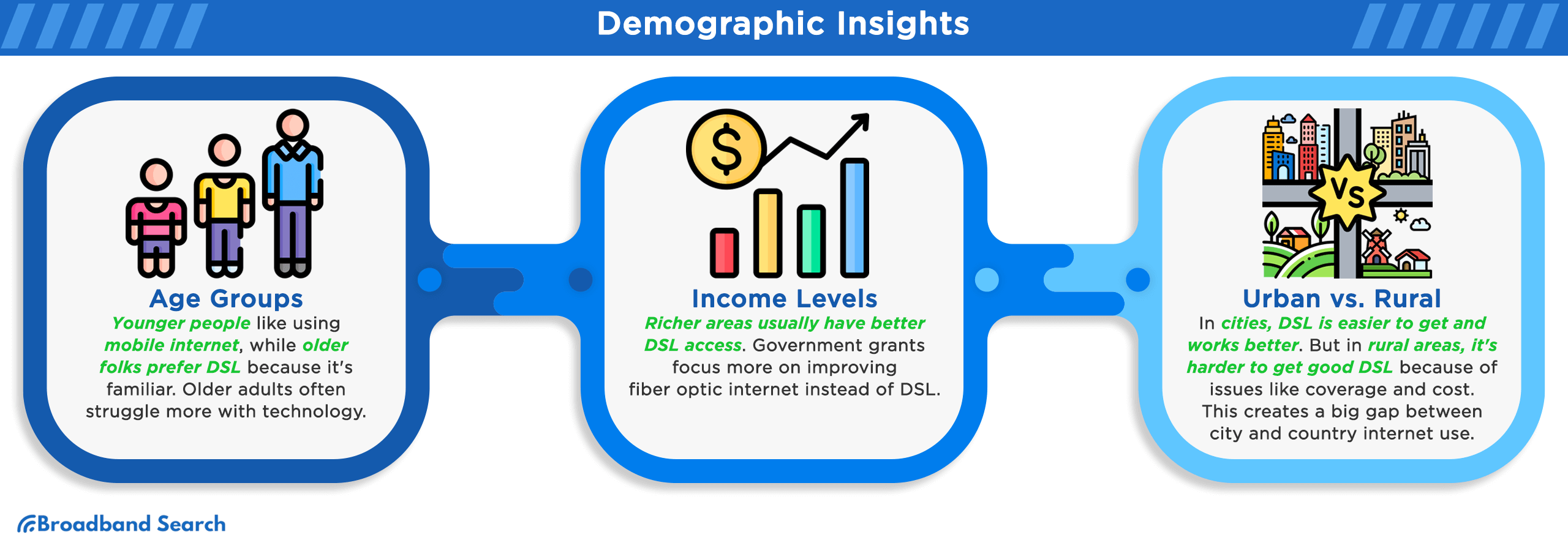
Age Groups and DSL Usage
The demographics of DSL usage vary significantly across different age groups, reflecting distinct preferences and usage patterns. This variation contributes to the digital divide, affecting how different age groups access and utilize DSL broadband.
Age-Related Preferences and Usage Patterns
- Younger generations, particularly Millennials and Gen Z, are more inclined towards mobile internet usage, favoring wireless and mobile broadband over traditional DSL.
- Older generations, such as Baby Boomers, show a higher preference for fixed broadband solutions like DSL due to their familiarity and reliability.
Digital Divide Issues Related to Age
- The digital divide is evident across age groups, with older adults often having lower digital literacy and technology adoption rates.
- The gap is not just in usage but also in accessibility; older populations in remote or underserved areas might rely more on DSL due to lack of advanced infrastructure.
- Efforts to bridge this divide include targeted digital literacy programs and infrastructure development aimed at improving access for older demographics.
Economic Status and DSL Access
The correlation between income levels and DSL accessibility is influenced by several factors, including demographics, socioeconomics, and infrastructure investments.
A study by Cornell University and The Pew Charitable Trusts found that only 12% of federally-funded broadband grants were allocated to DSL, with a focus on deploying fiber optic infrastructure instead. Research from ITIF revealed a significant correlation between higher income levels and increased broadband connectivity across major U.S. cities, suggesting that income is a key factor in predicting broadband coverage.
Urban vs Rural DSL Accessibility
In urban and rural settings, disparities in DSL availability and quality persist, illustrating the complex digital divide. While urban areas typically enjoy broader access and higher quality DSL connections, rural areas face challenges related to coverage, infrastructure, and affordability.
This urban-rural gap in broadband uptake, including DSL, is evident with a consistent disparity in internet usage between urban and rural users, standing at a 6-9% gap. The obstacles in rural areas are multifaceted, including not just service availability, but also economic, educational, and infrastructural factors, leading to a more pronounced digital divide in these regions
DSL Connectivity and Coverage Data in the US
Nationwide DSL Coverage Statistics
As of 2022, the percentage of U.S. households with access to DSL is less than 10%. This statistic is part of a broader trend in internet connectivity, where fiber and cable connections are becoming more prevalent. The market share for cable connections is just above 50%, while fiber accounts for over 20%, a significant increase from just over 10% in 2014.
Wireless and satellite options collectively make up less than 20% of the market. The decline in DSL and dial-up usage is expected to continue, with fiber poised to dominate the market in the near future.
Regarding comparisons with other broadband types:
- Cable Broadband: Cable internet typically offers higher maximum speeds compared to DSL. While DSL can reach up to 100 Mbps, cable broadband can offer speeds up to around 1,000 Mbps.
- Fiber-Optic Broadband: Fiber-optic connections are faster than both DSL and cable, often providing speeds that are several times higher. They can reach up to 10 Gbps in some cases, significantly outperforming DSL in terms of speed and reliability.
- Fixed Wireless and Satellite Broadband: These types are often used in rural or remote areas where DSL, cable, or fiber-optic connections are not available. While they provide internet access in such areas, their speeds and reliability can be less consistent compared to wired broadband types.
Regional Trends in DSL Coverage
2024 Regional Coverage Variations
- Northeast: States in the Northeast like Maryland, Virginia, and the District of Columbia have some of the fastest average internet speeds in the U.S., with Maryland leading at 506.7 Mbps. This suggests a well-developed internet infrastructure, which likely includes robust DSL coverage. Other states in this region, such as Pennsylvania, New Jersey, and Delaware, also show high internet speeds, indicating good overall broadband, including DSL availability.
- Midwest: States like Illinois and Minnesota have average internet speeds of 324.9 Mbps and 304.2 Mbps, respectively. It suggests a substantial DSL network presence, indicative of well-developed broadband infrastructure in the region. Other Midwest states like Missouri and Nebraska show slightly lower speeds, which could reflect variations in DSL coverage across the region.
- South: States in the South, including Florida and Georgia, demonstrate significant internet speeds (322.3 Mbps and 414.9 Mbps, respectively). This indicates a well-established broadband network. However, other states like Louisiana, Mississippi, and Alabama have lower average speeds, suggesting possible variations in DSL coverage and internet infrastructure across the South.
- West: California, despite its size and population, shows a surprisingly low average internet speed of 93 Mbps. In contrast, states like Oregon and Washington have higher speeds (316.9 Mbps and 451 Mbps, respectively). This disparity indicates varied levels of DSL and broadband infrastructure development across the Western states.
2023 Internet Access Methods Across States in the USA
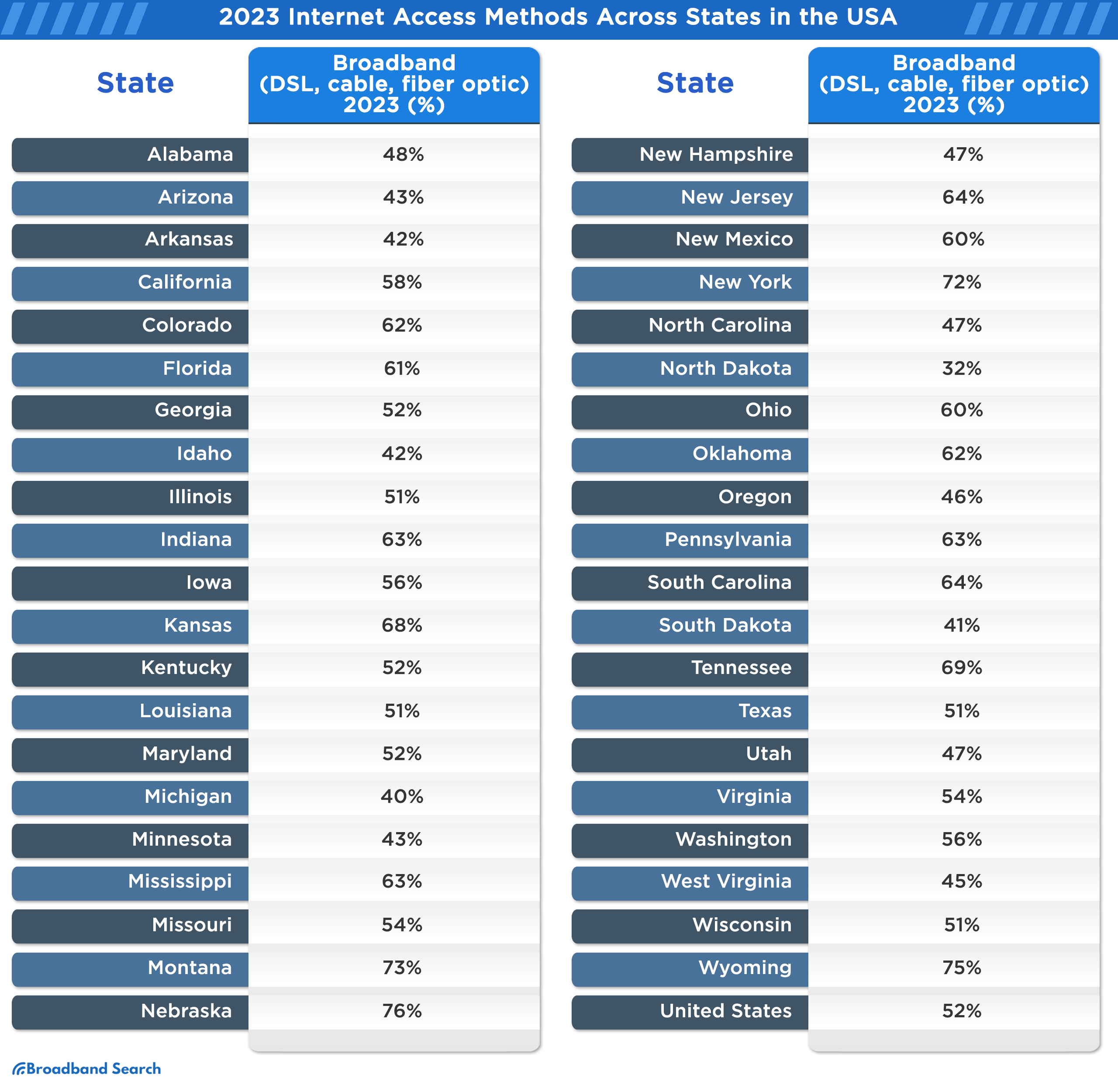
While some states achieved high broadband coverage rates, others lagged behind significantly. Here's a breakdown of broadband (DSL, cable, fiber optic) coverage by region:
- High Broadband Coverage: States with the highest broadband coverage rates included Washington (87%), New Jersey (83%), and Maryland (78%).
- Moderate Broadband Coverage: Several states like Texas (75%), Ohio (75%), and Illinois (68%) maintained moderate broadband coverage rates.
- Below-Average Broadband Coverage: A significant number of states fell below the national average, such as Mississippi (40%), Arkansas (43%), and California (43%).
- Low Broadband Coverage: Some states struggled with low broadband coverage, including Wyoming (32%), Montana (47%), and North Dakota (46%).
- Regional Disparities: Regional disparities in broadband access (DSL, cable, fiber optic) were evident, with the West and Northeastern states generally having higher coverage rates compared to some Southern and Midwestern states.
- Overall National Average: The national average for broadband access (DSL, cable, fiber optic) was around 62%, indicating that, on average, a substantial portion of the U.S. population had access to high-speed internet services through DSL, cable, or fiber optic connections.
Urban vs Rural Coverage in the US
Coverage Divide
Rural areas often lack access to broadband services. From 2016 to 2019, the urban-rural broadband access gap decreased from 30 to 16 percentage points. In 2019, nearly 3.7 million rural Americans gained 25/3 Mbps broadband, increasing rural coverage to 83%, up 15 points from 2016.
Speed Gap
Even where available, rural DSL speeds tend to lag far behind urban options. Average download speeds hover around 5-10 Mbps in rural areas, compared to 25-50 Mbps in urban centers. This disparity hinders online activities like remote work, streaming, and video conferencing.
Reliability Blues
Rural DSL connections are often plagued by instability and frequent outages. Factors like aging infrastructure and longer lines contribute to higher rates of dropped connections and service disruptions, impacting critical online activities.
Technological Leap
Advancements in fiber optic and satellite internet offer higher speeds and improved reliability in rural areas, but adoption remains slow due to cost barriers and infrastructure limitations. The gap between available technology and its widespread adoption persists.
DSL Market Analysis and ISP Market Share
ISP Market Share in DSL Services
The DSL market and ISP market share in 2024 show significant trends and key players:
Leading DSL Service Providers
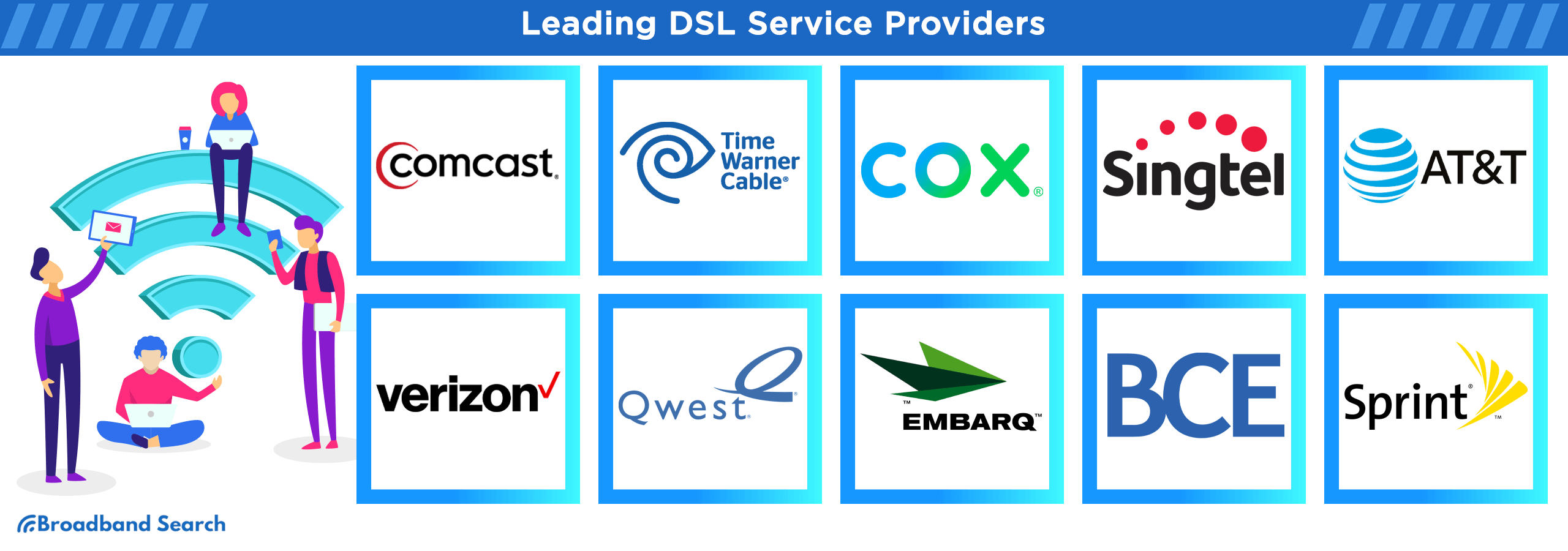
- Comcast: Known for extensive market presence and innovative service offerings.
- Time Warner Cable, Inc.: Focuses on delivering high-quality broadband services.
- Cox Communications, Inc.: Emphasizes customer service and network reliability.
- Singtel: Renowned for its technological advancements and wide coverage.
- AT&T: Offers diverse services with a strong focus on technology integration.
- Verizon Communications, Inc.: Known for high-speed services and technological innovation.
- Qwest Communications International, Inc.: Provides competitive broadband solutions.
- Embarq: Targets specific market segments with tailored services.
- Bell Canada Enterprises, Inc.: Focuses on expanding broadband access and services.
- Sprint Nextel: Emphasizes on delivering high-speed internet and integrated services.
Market Share Analysis
- Fiber Optics Dominance: The fiber optics segment holds the largest revenue share due to its high-quality network signals and capacity for continuous improvement.
- Wireless Broadband Growth: Wireless broadband services are anticipated to show the fastest growth, driven by technological advancements and user convenience.
- Business End Users: The business end-user segment captures the largest market share, reflecting the critical role of broadband in modern business operations.
- Household Segment Growth: The household segment is expected to grow significantly, driven by online learning, work-from-home trends, and entertainment needs.
Overview of the DSL Market
The DSL market, as of 2024, exhibits notable trends and competitive dynamics:
Market Size and Growth Trends
- DSL Modem Market: The global DSL modem market, which includes products like ADSL and VDSL modems, has seen changes in market size from 2021 to 2024. The market's performance is influenced by factors such as the type of modems and their applications in both home and commercial use. This market spans various geographic regions, including North America, Europe, Asia-Pacific, South America, and the Middle East and Africa.
- DSL Network Equipment Market: The DSL Network Equipment market covers different types of DSL technologies like IDSL, ADSL, RADSL, and SDSL. This market segment's growth is driven by factors such as technology transitions, vendor options, and market needs in residential, small-office, and big-office settings. The geographic scope of this market includes major global regions and countries, reflecting its diverse and evolving nature.
Competitive Landscape
- Major Players: The DSL market features key players such as Huawei Technologies, ZTE, Alcatel-Lucent, Nokia Siemens Networks, and Ericsson. These companies are leaders due to their performance, range of products, technical capabilities, and after-sales service.
- Market Dynamics: The competition in the DSL market is shaped by various factors, including new product launches, expansion, mergers and acquisitions, and partnerships. Companies are also focusing on overcoming challenges such as strict government regulations and supply chain disruptions. The market dynamics are influenced by the changing consumer preferences and technological advancements.
Future Outlook for DSL Market
The future outlook for the DSL market is marked by both emerging trends and potential challenges:
Emerging Trends
- Diverse Types of DSL Modems: The DSL modem market is evolving with various types like RADSL, ADSL, SDSL, and IDSL, each catering to different applications and offering unique advantages. This diversity is expected to drive the market forward.
- Increased Use in Gaming: DSL modems, particularly due to their high-speed capabilities, are increasingly being used in gaming. This trend is likely to continue as the demand for fast and reliable internet connections for gaming grows.
- Business and Personal Applications: Besides gaming, DSL modems are also extensively used for business and personal applications, indicating a broad market base.
- Regional Growth Variances: The DSL market is showing significant regional differences. Regions like North America are expected to see major growth due to technological advancements and rising adoption of interactive applications like videogames.
- DSL Chipsets Advancements: The DSL chipsets market is witnessing growth with key players like Broadcom, MediaTek, and Intel focusing on expanding their product portfolios. This indicates advancements in DSL technology, making it more efficient and versatile.
Potential Challenges
- Infrastructure Limitations: One of the key challenges facing the DSL market is the complexity in connecting distant and remote areas. This limitation affects the performance and speed of DSL services.
- Competition from Other Technologies: DSL faces stiff competition from other broadband technologies like fiber and 5G, which offer higher speeds and more reliable connections, especially in densely populated urban areas.
- Technological Evolution: The rapid evolution of internet technologies means that DSL needs continuous upgrades to remain relevant, posing a challenge for providers to keep up with the latest advancements.
The Takeaway
Our analysis reveals DSL's enduring presence in the internet landscape, particularly in areas with limited options. Despite advancements in technology, DSL remains a reliable choice for many, offering consistent service without the need for extensive infrastructure overhaul. Its resilience in remote and rural areas stands out, ensuring connectivity where alternatives are scarce or non-existent.
Looking ahead, DSL's role will likely evolve rather than diminish. As internet demands skyrocket, DSL's adaptability could serve as a complementary solution to newer technologies. Its potential in bridging digital divides, especially in under-served regions, positions it as a key player in ensuring universal internet access, a goal more crucial than ever.
FAQ
Can DSL work on any phone line?
DSL can work on most standard phone lines, but it requires a relatively modern and well-maintained line for optimal performance. Older or degraded phone lines may not support DSL effectively or may result in reduced speeds.
What factors affect the quality and speed of a DSL connection?
The quality and speed of a DSL connection are influenced by the distance from the service provider's central office, the quality of the phone line, and network congestion. Longer distances and poorer line quality can significantly decrease connection speeds.
Is DSL suitable for heavy internet usage like gaming or streaming?
For heavy internet usage like gaming or streaming, DSL can be sufficient, particularly if it's a higher-tier DSL service. However, its performance may not match that of fiber or cable, especially for ultra-high-definition content or competitive gaming.
Can I use DSL for VoIP (Voice over Internet Protocol) services effectively?
DSL can effectively support VoIP services, offering adequate bandwidth and latency for clear voice communication. However, its performance for VoIP might fluctuate during periods of high internet usage or network congestion.
How does weather affect DSL Internet connectivity
Weather conditions, particularly severe ones, can impact DSL Internet connectivity. Issues like line damage from storms or temperature fluctuations affecting the infrastructure can lead to temporary disruptions in DSL service.

